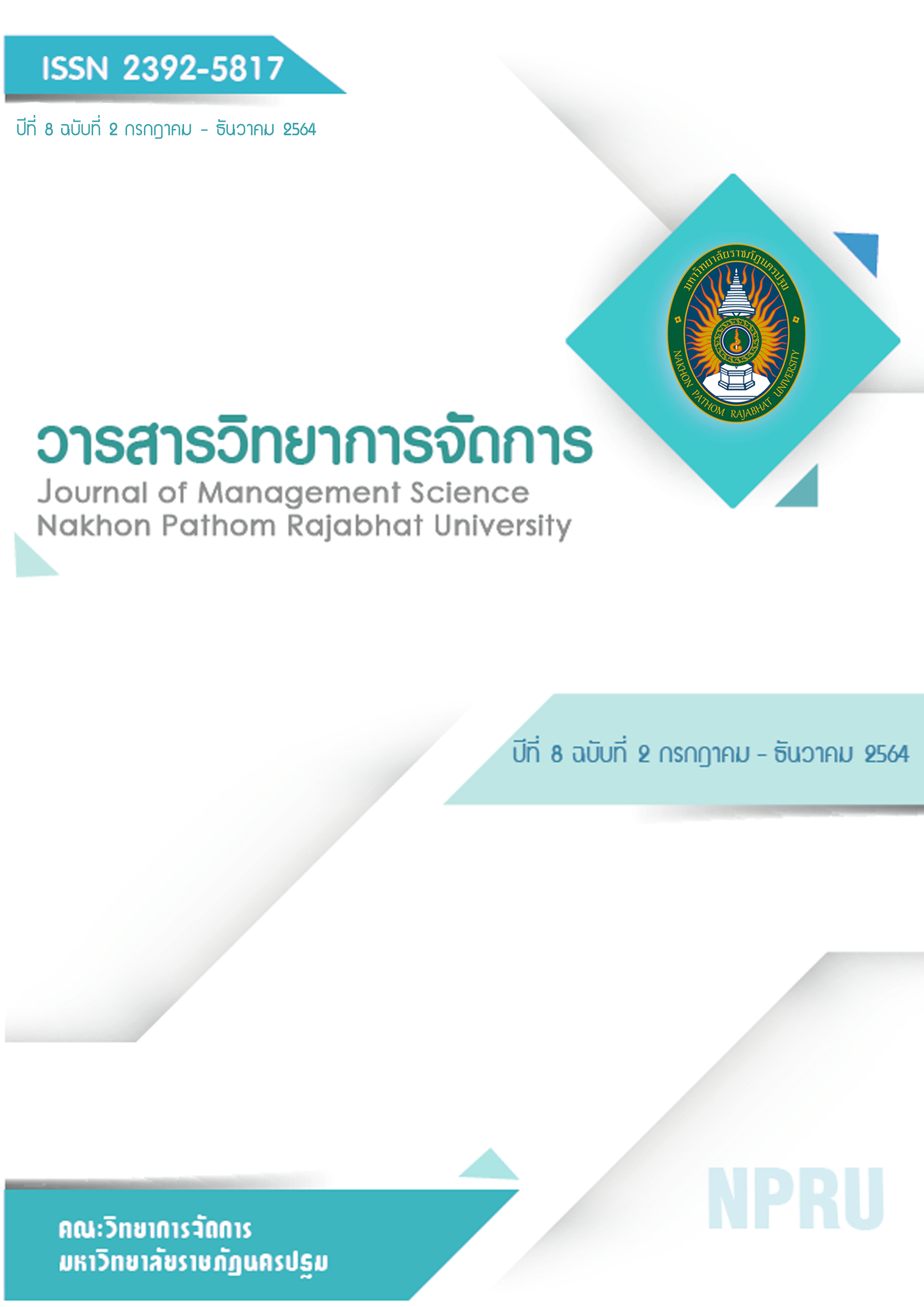ผลของการใช้โปรแกรมฝึกอบรมเพื่อเสริมสร้างความรู้ ต่อพฤติกรรม การเป็นผู้สูงอายุที่ประสบความสำเร็จ
Main Article Content
บทคัดย่อ
การวิจัยนี้มีวัตถุประสงค์ของการวิจัยเพื่อ 1) พัฒนาโปรแกรมฝึกอบรมเพื่อเสริมสร้างความรู้การเป็นผู้สูงอายุที่ประสบความสำเร็จ และ 2) ศึกษาผลของการใช้โปรแกรมฝึกอบรมเพื่อเสริมสร้างความรู้ต่อพฤติกรรมการเป็นผู้สูงอายุที่ประสบความสำเร็จ การวิจัยนี้เป็นการวิจัยกึ่งทดลอง ผู้สูงอายุตั้งแต่ 60-69 ปี เข้าร่วมอบรมตลอดการวิจัยจำนวน 35 คน โดยผู้สูงอายประเมินตนเองว่ามีพฤติกรรมการเป็นผู้สูงอายุที่ประสบความสำเร็จ สถิติที่ใช้วิเคราะห์ ได้แก่ ค่าความถี่ ค่าร้อยละ ค่าเฉลี่ย ส่วนเบี่ยงเบนมาตรฐาน การทดสอบที
ผลการวิจัยพบว่า
1. โปรแกรมฝึกอบรมเพื่อเสริมสร้างความรู้ของพฤติกรรมการเป็นผู้สูงอายุที่ประสบความสำเร็จมีการดำเนินงาน 2 ระยะ ได้แก่ ระยะที่ 1 พัฒนาโปรแกรมฝึกอบรมจากการศึกษาแนวคิดทฤษฎีงานวิจัยที่เกี่ยวข้องและประชุมกลุ่มย่อยกับผู้มีส่วนเกี่ยวข้อง ระยะที่ 2 ทดลองใช้โปรแกรมฝึกอบรม โดยแบ่งเป็น 5 หน่วย ได้แก่ สุขภาพกาย สุขภาพจิต การพัฒนาจิตวิญญาณ การสนับสนุนทางสังคม และการพึ่งพาตนเอง รวมทั้งหมด 30 ชั่วโมง โดยใช้วิธีการฝึกอบรมที่หลากหลาย ประเมินพฤติกรรมการเป็นผู้สูงอายุที่ประสบความสำเร็จหลังฝึกอบรม 1 เดือน
2. ผลของการใช้โปรแกรมฝึกอบรมมีดังนี้
2.1 ผู้เข้าอบรมมีคะแนนความรู้การเป็นผู้สูงอายุที่ประสบความสำเร็จเฉลี่ยหลังการฝึกอบรมมากกว่าก่อนการฝึกอบรมอย่างมีนัยสำคัญทางสถิติที่ระดับ .01
2.2 ผู้เข้าอบรมมีพฤติกรรมการเป็นผู้สูงอายุที่ประสบความสำเร็จหลังการฝึกอบรมมากกว่าก่อนการฝึกอบรมอย่างมีนัยสำคัญทางสถิติที่ระดับ .01
* อาจารย์ คณะวิทยาการจัดการ มหาวิทยาลัยราชภัฏนครปฐม 73000
Corresponding author:janjirapon@webmail.npru.ac.th
Article Details

อนุญาตภายใต้เงื่อนไข Creative Commons Attribution-NonCommercial-NoDerivatives 4.0 International License.
ทัศนะและข้อคิดเห็นของบทความที่ปรากฏในวารสารฉบับนี้เป็นของผู้เขียนแต่ละท่าน ไม่ถือว่าเป็นทัศนะและความรับผิดชอบของกองบรรณาธิการ
เอกสารอ้างอิง
เครือวัลย์ มาลาศรี และภัทรธิรา ผลงาม. (2559). การพัฒนาศักยภาพในการดูแลตนเองของผู้สูงอายุ : กรณีศึกษาในชมรมผู้สูงอายุ ตําบลสะอาด อําเภอน้ำพอง จังหวัดขอนแก่น. วารสารวิชาการมหาวิทยาลัยราชภัฏอุตรดิตถ์. 11(2). 26-38.
ประนอม โอทกานนท์ รัชนีภรณ์ ทรัพย์กรานนท์ วารี กังใจ และสิริลักษณ์ โสมานุสรณ์. (2557). การพัฒนาหลักสูตรฝึกอบรม เรื่องทักษะการจัดการความรู้ด้านการสร้างเสริมสุขภาพสาหรับผู้สูงวัย. วารสารวิทยาศาสตร์และเทคโนโลยี. 22(5). 716-730.
ประไพศิริ เชี่ยวสาริกิจ. (2555). คู่มือสูงวัยอย่างสมาร์ท. กรุงเทพฯ: มูลนิธิสถาบันวิจัยและพัฒนาผู้สูงอายุไทย (มส. ผส.).
ปิยะ ศักดิ์เจริญ. (2558). ทฤษฎีการเรียนรู้ผู้ใหญ่และแนวคิดการเรียนรู้ด้วยการชี้นำตนเอง: กระบวนการ เรียนรู้เพื่อการส่งเสริมการเรียนรู้ตลอดชีวิต. วารสารพยาบาลทหารบก. 16(1). 8-13.
พิเชษฐ ไพบูลย์ศิริ. (2555). การพัฒนาหลักสูตรฝึกอบรม เพื่อเพิ่มคุณภาพชีวิตผู้สูงอายุ. วารสารวิชาการ มหาวิทยาลัยอีสเทิร์นเอเชียฉบับสังคมศาสตร์ และมนุษยศาสตร์. 6(1). 191-199.
พิศุทธิภา เมธีกุล. (2554). ประสบการณ์การสูงวัยอย่างประสบความสำเร็จของผู้สูงอายุไทยที่มีสุขภาวะทางจิตสูง: การวิจัยเชิงคุณภาพแบบทีมผู้วิจัยเห็นชอบร่วมกัน. วิทยานิพนธ์ศิลปศาสตรมหาบัณฑิต สาขาวิชาจิตวิทยาการปรึกษา สาขาวิชาจิตวิทยาการปรึกษา จุฬาลงกรณ์มหาวิทยาลัย
มณฑา ไชยะวัฒน และวิเชียร ตันสุวรรณนนท์. (บรรณาธิการ). (2559). คู่มือหลักสูตรโรงเรียนผู้สูงอายุเขตสุขภาพที่ 5. ราชบุรี: ศูนย์อนามัยที่ 5 ราชบุรี กรมอนามัย.
วณิช นิรันตรานนท์ และศศิธร นิรันตรานนท์. (2555). การพัฒนาหลักสูตรการดูแลสุขภาพตนเองของผู้สูงอายุ : รูปแบบการฝึกอบรมการดูแลสุขภาพโดยใช้กิจกรรมพลศึกษา สุขศึกษา นันทนาการและวิทยาศาสตร์การกีฬา. อุดรธานี: สถาบันการพลศึกษา วิทยาเขตอุดรธานี.
ศศิมา พึ่งโพธิ์ทอง ทิพวรรณ ตั้งวงษ์กิจ อรนุช นุ่นละออง มยุรี บุญทัด และนันท์ชวัล คณาสุริยพัฒน์. (2562). ประสิทธิผลของโปรแกรมการปรับเปลี่ยนพฤติกรรมสุขภาพตามหลัก 3อ.2ส. ของผู้สูงอายุโรคความดันโลหิตสูง อำเภอสรรคบุรี จังหวัดชัยนาท. วารสารแพทย์นาวี. 46(3). 581-591.
สมพร กันทรดุษฎี เตรียมชัยศรี. (2562). สร้างเสริมสุขภาพด้วยสมาธิบำบัดแบบ SKT 1-7. [ออนไลน์]. ค้นเมื่อ 8 มกราคม 2562, จาก https://thaicam.go.th/wp-content/uploads/2019/06/14-2.pdf
สำนักงานส่งเสริมสวัสดิภาพและพิทักษ์เด็ก เยาวชน ผู้ด้อยโอกาส และผู้สูงอายุ. (2556). ชุดความรู้เพื่อการเตรียมความพร้อมเข้าสู่วัยสูงอายุที่มีคุณภาพ. กรุงเทพฯ: กระทรวงการพัฒนาสังคมและความมั่นคงของมนุษย์.
สำนักงานสถิติแห่งชาติ. (2557). การสำรวจประชากรสูงอายุในประเทศไทย พ.ศ. 2557. กรุงเทพฯ: บริษัท เท็กซ์ แอนด์เจอร์นัล พับลิเคชั่น จำกัด.
สำนักอนามัยผู้สูงอายุ กรมอนามัย. (2560). สมุดบันทึกสุขภาพผู้สูงอายุ. กรุงเทพฯ: ศูนย์สื่อสิ่งพิมพ์แก้วเจ้าจอม มหาวิทยาลัยราชภัฎสวนสุนันทา
สุธรรม นันทมงคลชัย. (2561). ผู้สูงอายุที่ประสบความสำเร็จ : บทเรียนเพื่อการเตรียมตัวที่ดี. [ออนไลน์]. ค้นเมื่อ 20 กรกฎาคม 2561, จาก http://phfh.ph.mahidol.ac.th/article.pdf.
อรทัย อาจอ่ำ. (2553). แก่แล้วไม่มีคุณค่าจริงหรือ?บทสังเคราะห์ความรู้เกี่ยวกับคุณค่าของผู้สูงอายุ. การประชุมวิชาการระดับชาติครั้งที่ 6 สถาบันวิจัยประชากรและสังคม มหาวิทยาลัยมหิดล.
อัมพร เบญจพลพิทักษ์ กาญจนา วณิชรมณีย์ และพรรณี ภาณุ วัฒน์สุข. (2556). คู่มือความสุข 5 มิติสำหรับผู้สูงอายุ. นนทบุรี: สำนักพัฒนาสุขภาพใจ กรมสุขภาพใจ.
อุไร เดชพลกรัง. (2554). ทัศนะของนักศึกษามหาวิทยาลัยธรรมศาสตร์ต่อการเป็นผู้สูงอายุที่มีศักยภาพ. สังคมสงเคราะห์ศาสตรมหาบัณฑิต. การบริหารและนโยบายสวัสดิการสังคมมหาวิทยาลัยธรรมศาสตร์.
Cosco, T. D., Prina, A. M., Perales, J., Stephan, B. C., & Brayne, C. (2014). Operational definitions of successful aging: a systematic review. International Psychogeriatrics, 26 (3), 373-381.
Dahany, M. M., Dramé, M., Mahmoudi, R., Novella, J. L., Ciocan, D., Kanagaratnam, L., & Jolly, D. (2014). Factors associated with successful aging in persons aged 65 to 75 years. European Geriatric Medicine. 5(6). 365-370.
DeNisi, A. S., & Griffin, R. W. (2008). Human Resource Management. Boston: Houghton Mifflin Company
Dessler, G. (2013). Human resource management. (13th ed.). USA: Pearson Education.
Gwee, X., Nyunt, M. S. Z., Kua, E. H., Jeste, D. V., Kumar, R., & Ng, T. P. (2014). Reliability and validity of a self-rated analogue scale for global measure of successful aging. The American Journal of Geriatric Psychiatry. 22(8). 829-837.
Hair, J. F., Black, W. C., Babin, B. J., & Anderson, R. E. (2010). Multivariate data analysis.
(7th ed.). Upper Saddle River, NJ: Pearson Prentice Hall.
Johnson-Conley, C.D. (2009). Using community-based participatory research in the development of a consumer-driven cultural competency tool. Ph.D. Thesis, University.
Kim, E. J. (2013). Accessing factor structure and construct validity of the successful aging inventory. Journal of Korean Academy of Nursing, 43 (4), 568-578.
Lesinski, M., Hortobágyi, T., Muehlbauer, T., Gollhofer, A., & Granacher, U. (2015). Effects of balance training on balance performance in healthy older adults: a systematic review and meta-analysis. Sports medicine, 45 (12), 1721-1738.
Noe, R. A., Hollenbeck, J. R., Gerhart, B., & Wright, P. M. (2011). Fundamentals of human resource management. (4th ed.). Boston: McGraw-Hill.
Osterlind, S. J. (2002). Constructing Test Items: Multiple-Choice, Constructed-Response, Performance, and Other Formats. (2nd ed.). NY: Kluwer Academic Publishers.
Rowe, J. W., & Kahn, R. L. (1987). Human aging: Usual and successful. Science. 237. 143-149.
Rowe, J. W., & Kahn, R. L. (1997). Successful aging. The Gerontologist. 37. 433-440.
Russell, S. S. (2006). An overview of adult-learning processes. Urologic nursing. 26 (5). 349-352.
Tate, R. B., Loewen, B. L. , Bayomi, D. J. , and Payne, B. J. (2009). The Consistency of Definitions of Successful Aging Provided by Older Men: The Manitoba Follow-up Study. Canadian Journal on Aging, 28 (4), 315– 322.


